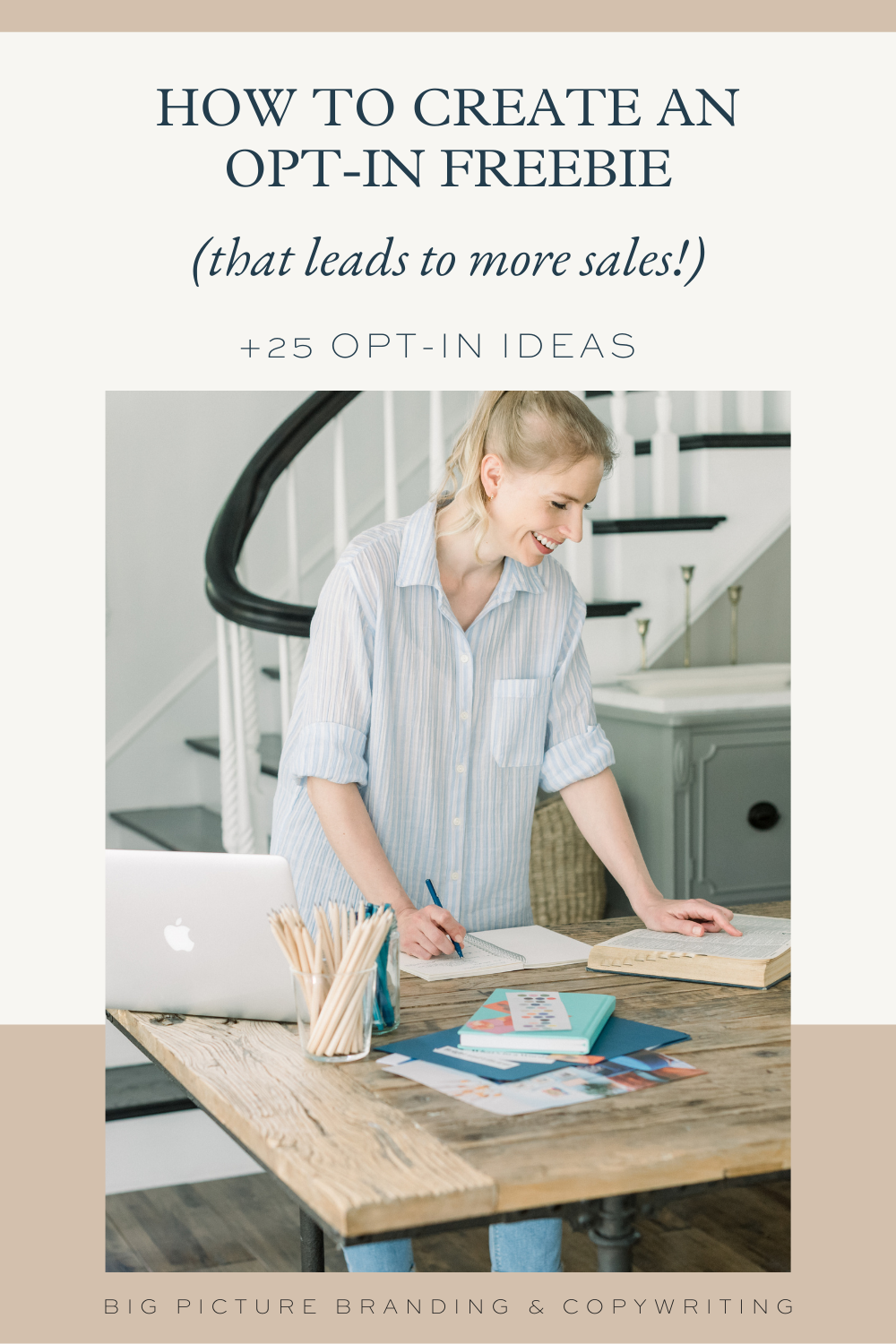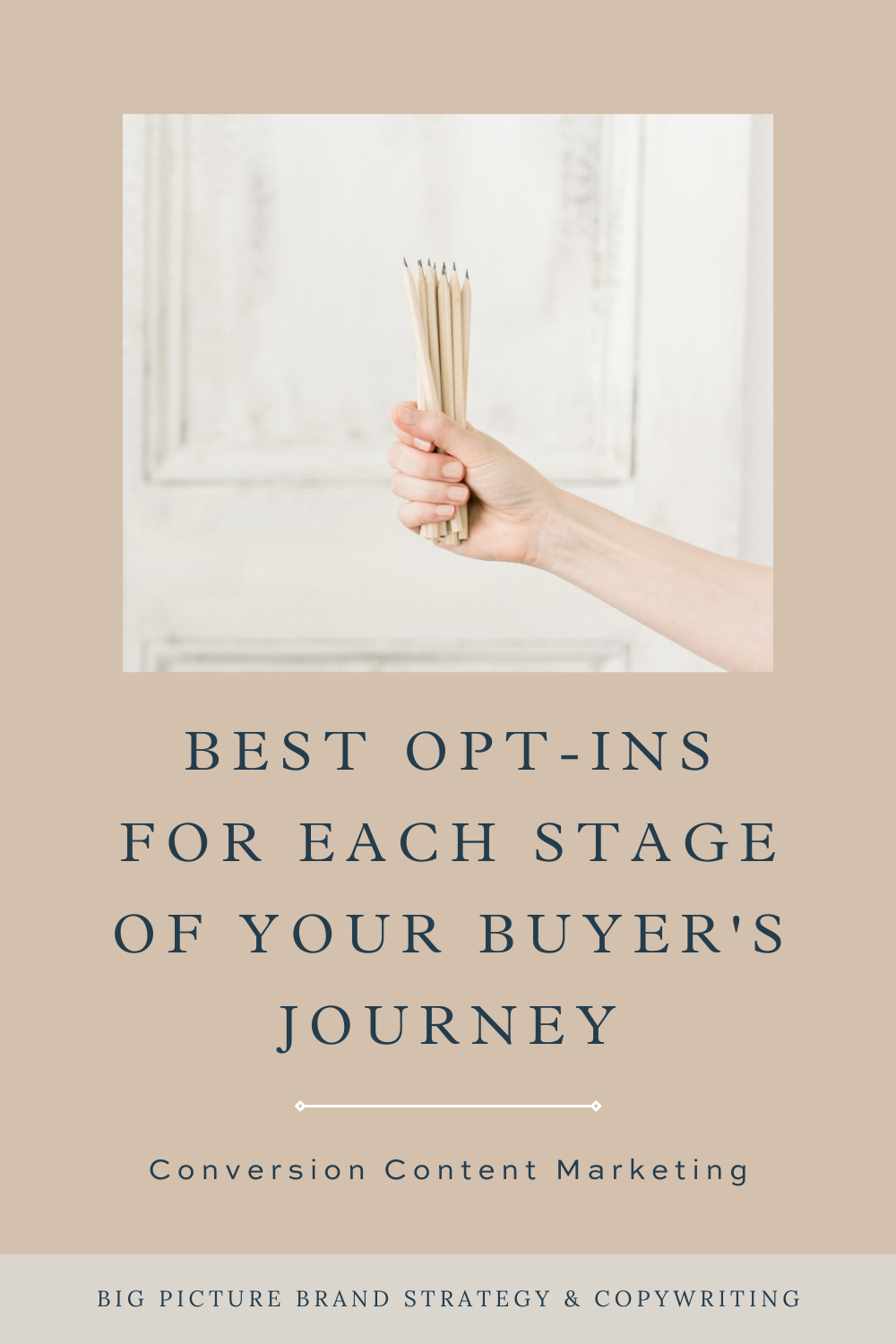If you work in a creative field or are an online service-based business, people are coming to you to find a solution to a problem they’re not sure how to solve themselves. But sometimes, when your audience doesn’t know your field as well as you, conveying your value (and your price point) can feel like an uphill battle.
We’re told that we need to “educate” our audience through free content marketing, but often our audience members are at different stages in the buying journey. (I call them the Early-Stage Susies, On-The-Fence Frannies, and Ready Betties down below!)
Educating your audience doesn’t mean you need to become a slave to the Content Marketing Machine™️. You don’t need a huge resource library or a dozen freebies to educate or validate your products and services. I say you can do it with three strategic opt-ins. (When I look at my own analytics, I have, in fact, three pieces of content that outperform the rest by miles.)
The beauty in having three strategic opt-ins is it allows you to showcase different elements of your business or process while serving up one piece of content that is relevant to each segment of your audience.
(a.k.a. the Susies, Frannies, and Betties.)
I suggest choosing one opt-in to satisfy each stage of the buying journey. You can place all three the opt-ins across a designated banner or section of your homepage or make them their own resources page. No matter where you place them, they should be highly discoverable and not require someone to click more than two levels deep into your website.
Here are my top three freebie content opt-ins based on your audience.
Start here:
Ask yourself the following:
-
How much do people already know about your field or what you do?
-
Is “the gist” enough and or do you need to get into the nitty-gritty of how you do what you do?
-
How much more information does your audience need to know or learn in order to judge whether your services and products are right for them?
-
What are the three most valuable pieces of content you want to share with your audience that showcases your knowledge, process, and/or solution?
Let those questions percolate while you consider the buying journey…
Early-Stage Susies
Early-stage Susies need to be qualified, for your sake and theirs. These people have a problem, found their way to you (perhaps via search or referral) but are a little directionless, or don’t have concrete goals in mind yet. They’re often new to the online business world and happy to be learning under your wing for now. Focus your Top 3 on helping them further understand their problem, learn about themselves, and see how what you do is perfectly positioned to help them (or not!)
-
Quiz: A self-discovery quiz can help them better understand their goals, strengths, or weaknesses and begin to funnel them toward whichever solutions or product suits them best. (Tonic Site Shop does this brilliantly with their Brand Cocktail Quiz to help you figure out which of their website templates is right for you.) A quiz is also a prime location to start asking strategic questions and collecting audience research data about what they struggle with most, and what kinds of solutions appeal to them most.
-
Workbook: Workbooks are an excellent way to serve the segment of your audience who probably won’t have the ability to work 1:1 with you but might love your thought process so much that they will invest in your digital products or low-ticket offers. Plus, the best clients are the ones who know their own limits. A workbook gives potential clients a chance to peek inside your process and decide if DIY-ing isn’t going to quite take them all the way, but working with you 1:1 will. Many of my clients started by downloading my Brand Personality Workbook and validating my approach before reaching out.
-
Downloadable Asset or Printable: A time-tracker, desktop wallpaper, SEO checklist, affirmation card — the key is to make sure it is something they will continue to look at or reference every single day. Make sure your branding is visible. Downloadable assets need to deliver a quick win and keep you top of mind every time they go to complete a task related to something you offer.
On-The-Fence Frannies
These people need to be convinced of your value more than any other audience stage. It’s likely they are investing in themselves or their business for the first time and are nervous about dropping the cash. They’re nervous about making a mistake and feeling buyer’s regret so they’re eager to sample the goods before making the purchase. Letting them try before they buy and offering a little more “hand-holding” is necessary for the Frannies of the world. (P.S. This is where a welcome or nurture sequence really helps with conversions.)
-
How-To: The goal of this particular how-to is to teach them something (part 1) that leads them to a specific offer they would find valuable (part 2). For example, if you want to sell your wedding photography client brochure template, write about how to price your packages for profitability. Once they’ve figured out their pricing, you’re there with the next piece of the puzzle. If you’re selling your coaching services, write about three exercises someone can try to tackle the #1 problem they face. This how-to is a gentle nudge to reassure them they are moving in the right direction and if they need your help, you’re right there and ready for them.
-
Template: The difference between a template and a workbook is that a workbook is about reflection and discovery, whereas a template is all about execution. This is where you’re able to let them try out your process and demonstrate that your framework works and is easy to follow. Templates that work build trust, trust makes it easier to sell, and once someone has purchased something once, they’re more likely to become a repeat buyer.
-
Workshop: Similar to the how-to, your workshop (which can be pre-recorded!) should teach and lead them to where you want them to go to next. However, a workshop is not a 55-minute sales pitch. Your goal is to teach a concept thoroughly enough that someone could walk away, apply what they learned to their business, and get immediate results.
Ready Bettys
These people have their credit cards out and are on the hunt for someone to give it to. Solution-focused, it’s up to you to show them quickly and succinctly that you’ve got a signature process and proof of results. And a weird truth to consider is that trust in the online world tends to be measured by “do I like you?” Your personality should come through your website copy, design, and opt-ins. Don’t forget, you’ll likely need to offer an avenue to connect with you face-to-face to seal the deal.
-
Webinar Replay: Love ‘em or hate ‘em, a high-value, low-fluff, pre-recorded webinar is an excellent way to show Betty you’re a pro who’s been doing this for a long time and are getting the results they want.
-
Case Study / Showcase: This opt-in works for someone in a highly competitive space looking for you to apply your signature process to their business. And I’m not talking about a page on your website that lays out the problem/solution/result snoozer we’re all used to. I’m talking about creating a really compelling case study (“Zero to $200K in a Day: How [Client Name] launched her course using the [Your Signature Offer]”). Teaser bullets promising nuggets of information should intrigue someone about your secret sauce or approach. Whether delivered as a password-protected landing page or a PDF magazine, be sure to include a CTA to reach out to discuss how you will be able to deliver results like shown.
-
Behind-the-Scenes Tour: This can be delivered as a password-protected landing page or as a series of emails and should include photos and videos of you and your team at work. A BTS tour works well for small teams and agencies where your potential client might end up working with multiple people and needs to trust that you’ve got a great crew at the ready.
Creating your Top 3 is a great alternative to having a blog and they are great assets to nurture your audience with inside your welcome email sequence (one of the four things you need to launch a minimally viable website).
If you’re unsure where your audience sits in the buying journey, a quick 1-click survey inside your email welcome sequence is a simple way to gather that info so you can figure out which opt-ins would best serve your audience.
Want more opt-in examples? I’ve 25 ideas for you to choose from in this post here ⤵️.

PIN TO SAVE FOR LATER

